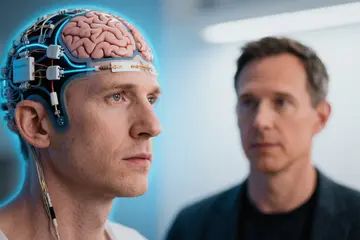?? Neuralink, Elon Musk's ambitious brain-computer interface (BCI) venture, has released its first human trial results. From enabling paralyzed patients to control devices with their minds to sparking debates on neuroethics, this breakthrough is reshaping the future of human-machine interaction. Here's what you need to know!

1. The First Human Implant: How It Works
In January 2024, Neuralink successfully implanted its N1 chip into 29-year-old Noland Arbaugh, a quadriplegic patient. The PRIME Study aimed to test the safety and functionality of the device, which uses 1,024 ultra-thin electrodes to record neural activity. The surgery was performed by the R1 robot, designed for precision placement in the brain's motor cortex.
Mind Over Matter: Early Results
Initial outcomes were promising—Noland could browse the web, play video games, and type using only his thoughts. By February 2024, cursor control reached 8 bits per second, rivaling traditional mouse use. Later participants even manipulated 3D design software, showcasing the potential for creative applications.
2. Successes and Setbacks
While patients reported life-changing improvements, technical challenges emerged. Noland's implant initially lost 85% of signal fidelity due to electrode displacement. Neuralink addressed this with a software update, improving sensitivity in the remaining threads. By April 2025, all three trial participants were using the device independently for over 6.5 hours daily.
A Breakthrough for ALS Patients
Patient 3, Brad, who has late-stage ALS, regained the ability to communicate without eye-tracking devices. Neuralink is now integrating AI language models to restore his synthetic voice, marking a milestone for nonverbal individuals.
3. Ethical and Regulatory Challenges
The trial has sparked intense debate. Critics highlight risks like neural data privacy breaches and potential misuse. Regulatory bodies, including the FDA, initially raised concerns about brain inflammation and device longevity. Post-approval, Neuralink must provide long-term safety data spanning 20 years.
The Road Ahead: Neuralink's Vision
Musk envisions applications beyond medical rehabilitation, including thought-controlled robotics and seamless VR integration. Global trials are expanding, with plans for 30+ implants by 2026. However, ethical concerns about accessibility and neuro-inequality persist.
Key Takeaways
Medical Milestone: Quadriplegics achieved digital independence through mind-control.
Technical Hurdles: Electrode stability remains a challenge, requiring ongoing innovation.
Future Implications: Merging AI cognition with human brains could redefine human potential—or deepen societal divides.
See More Content About AI NEWS
